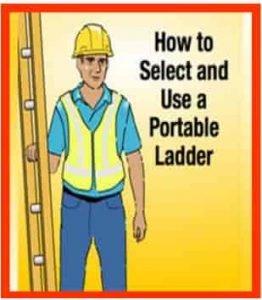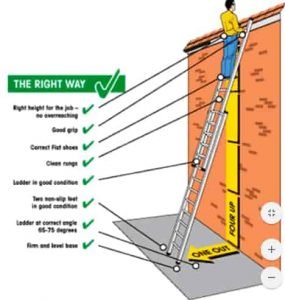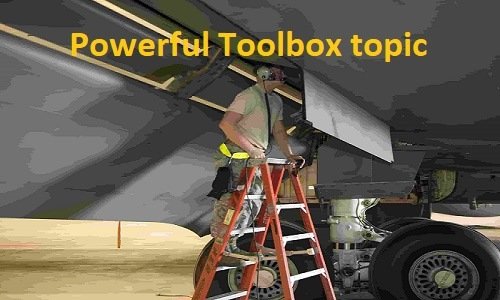Contents
Ladder Safety Toolbox Talk
Portable Ladders
Don’t let the simplicity of a ladder lull you into thinking accidents won’t happen.
Always make sure that you choose the right ladder for the job. Remember these guidelines:
- Type I –A: Ladders are heavy duty and are “rated” to handle up to 300 pounds (136 kilograms)
- Type I: Ladders are rated for up to 225/250 lbs. (102/ 113 kg) – check the label on the side rail of the ladder
- Type II: Ladders are rated for up to 200 lbs. (90 kg)
- Type III: Ladders are for “light duty” only
Ladders also vary in length. Choose one that is high enough for the job, but not so
high that it becomes a hazard.
Once you have chosen your ladder, inspect it thoroughly, keeping the following in mind:
CLICK HERE FOR ? LADDER SAFETY IN DETAILS

- Rungs/step must be clean and free from grease or oil.
- Make sure there are no splinters or sharp edges.
- Must ensure that metal ladders are not dented or bent.
- Safety feet should be in place.
- All supporting, braces and bolts must be present and fully secure.
- On extension ladders, make fully sure rope is not torn or frayed.
- Don’t allow more than one person on a ladder at one time.
There are also numerous general safety tips to keep in mind. For example:
- Use fall protection when working off a ladder (Refer to Site-Specific rules concerning the height).
- When feasible, “tie off” all ladders more than 6 ft. (1.82 m) in height.
- Never use aluminum ladders around live electrical services or welding.
- Make sure the ladder’s feet are parallel to the surface it rests against.
- Keep both hands free when ascending or descending.
- Avoid excessive stretching or leaning.
- Avoid the top step and platform of a stepladder and the top four rungs on straight ladders.
- Do not use damage and uncertified ladder.
CLICK HERE FOR ? Construction Site Safety Checklist
For straight/extension ladders:

- Make sure the top is anchored.
- When used for access, extend the ladder 3 ft. (0.9 m) above the landing.
- Place the ladder so that the distance from the base of the supporting object to the base of the Ladder is one-quarter of the distance from the base of the ladder to the top of the supporting object.
For stepladders:
- Make sure the hinge spreader is working properly.
- Have someone hold the ladder when on unstable ground or when applicable.
Falls from Ladders are a significant cause of injuries in Construction. Take preventive measures at all times before climbing on any type of Ladder. Think safety – ZERO INCIDENTS – throughout each and every task!
OIL AND GAS SAFETY OFFICER INTERVIEW QUESTIONS






This Site is Really helpful site. please visit everybody one time and gain more than more safety knowledges regarding safety.
Thanks for the shared safety topics.
Anything on assessment and improvements work sites?
Thanks to rlshumancare for providing safety update it will be help more help us.
Thanks rishumancare for the information, it would greatly help me to solve many safety issues.
Thanks for rlshumancare
Thanks to rlshumancare for providing safety updates it will help more help us